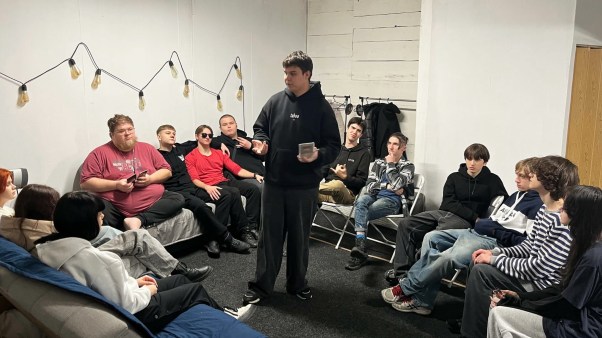Do children belong with the congregation in worship? Some churches cautiously answer, “Maybe as long as they’re quiet and require no special attention.” Others say, “Part of the time,” so children leave after a hymn and a children’s sermon. Several churches respond with a definite “No.” They plan an alternate activity, frequently a worthwhile activity, outside the sanctuary.
Our church found it hard to reconcile these three answers with our faith. We follow a Lord who welcomed children and called us to learn from them. We stand in a biblical tradition that instructs parents to answer children’s questions in the midst of a most significant celebration, the Passover.
We’ve learned we cannot honestly fulfill our vows to nurture children in Christ without nurturing them in worship. We’re expressing our ‘yes’ to children in corporate worship in at least six ways:
We state our intentions clearly. Children are welcome in our worship at any age. We want them; we need them. They need the experience of growing in worship with their church family. It’s an officially adopted policy of our governing board and a constantly publicized policy among our members through personal letters, pastoral visits, and classes.
We’re as diligent about inviting children to worship as we are to vacation church school, day camp, or choirs. We make sure our scheduling never compels families to choose between study and praise.
We support parents as God’s primary teachers of worship.
“My child bothers the people around her.”
“Kim doesn’t want to come to church. It’s such a battle.”
“I get nothing from the service if I have two wiggling children beside me.”
“We want Johnny to worship, but what can he understand about the service?”
We plan a class where parents can share these concerns and then seek answers together. The study includes our theology of worship, the relation of home worship and corporate worship, how children perceive and participate in worship at different levels of development, and the biblical model of parents in worship with children-as interpreters, not disciplinarians.
We analyze how children are prepared for public school and find many of the same strategies are valuable in preparing children for corporate worship. We offer resources: tapes of hymns, anthems, and service music children will hear in church, books explaining symbols and colors they will see, and a variety of helps for home worship. Periodically we send out a bulletin on such subjects as “How to Use a Pencil in Worship” or “How to Listen to a Sermon.”
We educate children for worship. Children learn to worship by worshiping with those they love and trust. But we can increase participation with education outside the sanctuary. This is most effective between ages five through eight.
For early elementary children and their parents, we have a class on worship and the sacraments. The sessions give children and parents a chance to explore the sanctuary together, practice passing an offering plate or Communion tray, use the hymnbook, sign the fellowship record, and follow a bulletin (called a worship guide in our church). First graders are given a hymnbook and are encouraged to put to work the skills they are learning in school-counting, recognizing words, scanning lines.
Our choir program emphasizes worship leadership, not performance. Choristers learn the Apostles’ Creed, the Lord’s Prayer, and any responses that will be part of the service. Their music is an integral part of our liturgy.
The Bible suggests children are apprentices in worship. The questions they ask are part of their offering to God. So we continue education in worship. We may practice a new hymn or Scripture reading just before the prelude. We seldom print a picture of the church on our worship guide. We use the space to teach about a symbol, a season of the church year, a mission emphasis, or a key word in the Scripture for that day. We give each child a worship kit, containing pencil, bookmarks, some instruction about how to use the worship guide that day, and an activity that will help them listen to at least one point in the sermon.
We help children contribute. We often act as if the main purpose of children in worship is to be quiet and sit still. But we are trying to act on our belief that worship for both adult and child means to glorify God. Our children participate, then, as any other worshiper, through praise, prayer, confession, and attention to God’s Word. Our education helps them do this with understanding. We avoid discrimination when hymnbooks are distributed, when bulletins, pledge cards, or fellowship records are given, or when the offering plate is passed. It’s surprising how, without some reminder, adults tend to keep the hymnbooks while children stand and gaze idly around during singing.
Children contribute to worship in many of the ways adults and youth contribute. They are invited to serve as ushers, greeters, and choir members. They may help prepare the sanctuary by sharpening pencils, checking the pew racks for supplies, and designing and hanging banners. They design worship guide covers or bulletin inserts that interpret the Scripture, the season, or a mission emphasis. They write prayers and announcements. They may assist the pastor in selecting Scripture for a call to worship, assurance of pardon, or benediction. One of their favorite activities is baking bread for Communion.
We plan worship for all ages. Worship that includes children is not childish. Our worship service is quite traditional with no gimmicks, but the minister conscientiously plans with adults, youth, and children in mind. The sermon begins with an illustration or question that speaks to all ages. Analogies may come from Dr. Seuss or ancient history. A prayer for peace is raised for the Middle East and the soccer field. The message of the gospel will be applied to those who fear death, job failure, and the dark. At least one hymn each Sunday will have a repeated phrase and recognizable printed pattern (an aid to failing eyesight as well as beginning readers). Scripture is read in a variety of ways: responsively, with solo voices, with a readers’ theater technique.
This has also caused us to alter our bulletin. Our guide to worship uses verbs rather than nouns (“We Prepare to Worship God,” not “Prelude”; “We Praise God,” not “Hymn 100”). We number the acts of worship because this helps children follow the sequence and keep up. We use large print and are careful about spacing.
We work to create a climate of welcome for all. Our church is in a retirement community, and almost 75 percent of our members are over sixty-five. Like most adults, they don’t know how to behave around children. We have a children-in-worship committee that, among other duties, interprets the needs of children to staff and congregation. For example, a committee member will be present when ushers are trained or the stewardship emphasis is planned. (What does it mean when you greet a young worshiper by name? Can children use the same pledge cards adults will use?) We’ve had some happy experiences matching temporary grandparents with a child who needs someone to sit with in church.
Saying yes to children in worship means continuous prayer, study, education, public relations, staff cooperation, and planning-in short, hard work.
It also means more children and families worshiping together; parents with more confidence in their ability to nurture; more vivid, concrete, and concise sermons; more specific prayers; services marked by color, drama, warmth, humor, and imagination; and a weekly demonstration of what it means to be the body of Christ, united across age differences.
By attending carefully to the child he has placed in our midst, we have all been enriched.
Virginia Thomas is a member of Westminster Presbyterian Church, New Port Richey, Florida.
Copyright © 1983 by the author or Christianity Today/Leadership Journal. Click here for reprint information on Leadership Journal.








